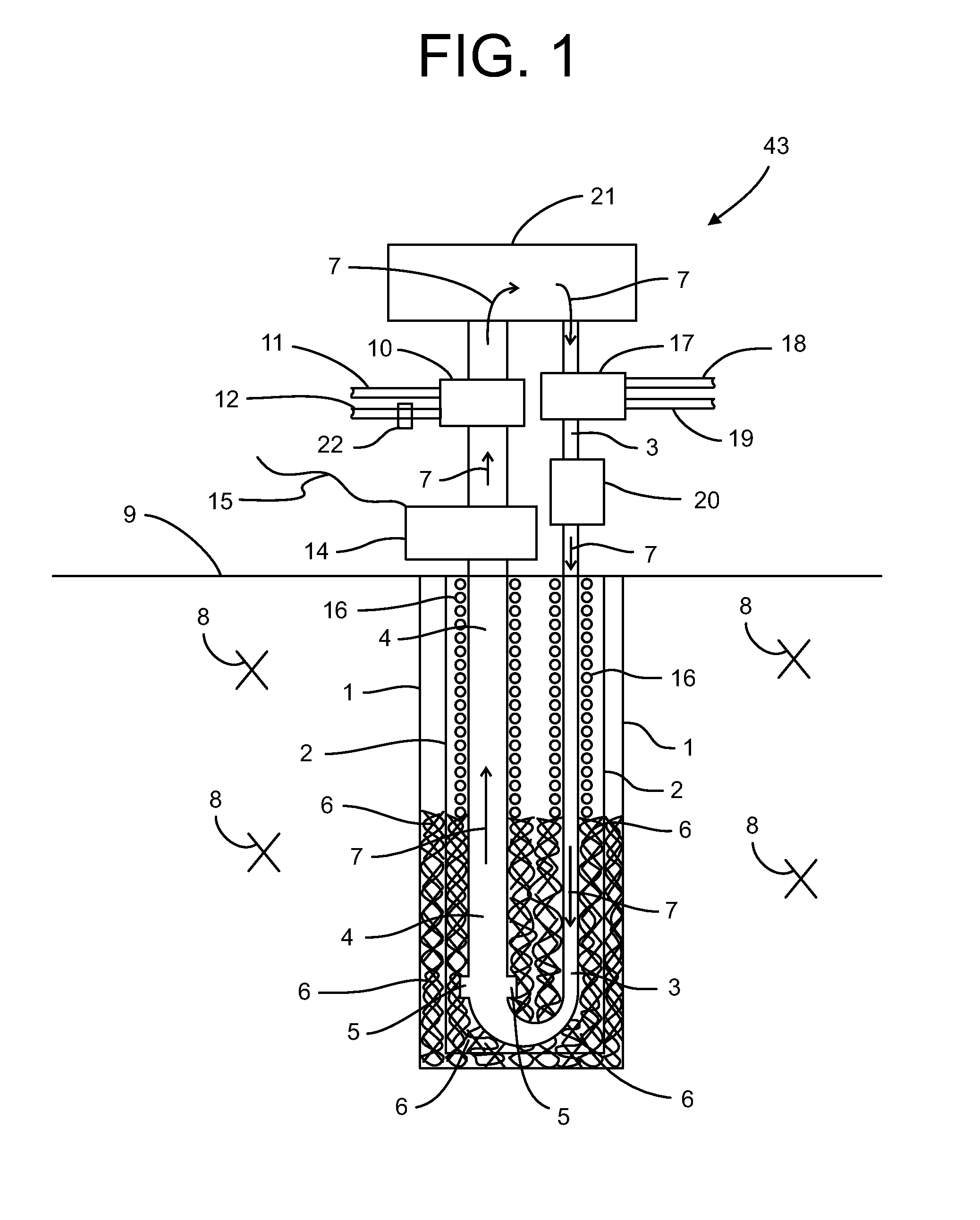Direct exchange geothermal refrigerant power advanced generating system
a technology of geothermal refrigerant and advanced generating system, which is applied in the direction of machines/engines, mechanical equipment, light and heating apparatus, etc., can solve the problems of inability to access such inability to economically develop, and inability to meet the needs of high-level natural heat conditions, etc., to achieve enhanced flow rate, improved power production efficiency, and reduced boiling point/temperature
- Summary
- Abstract
- Description
- Claims
- Application Information
AI Technical Summary
Benefits of technology
Problems solved by technology
Method used
Image
Examples
first embodiment
[0059]Referring now to the drawings in detail, where like numerals refer to like parts or elements, FIG. 1 is a side view of a direct exchange geothermal power generating system 43 constructed according to the present disclosure based upon refrigerant (indicated by directional flow arrows 7) being heated, phase changed into a vapor, and pressurized by the naturally occurring geothermal temperature within a well 1. Here, power is primarily derived via pressurized refrigerant 7 vapor driving a turbine / generator 14.
[0060]FIG. 1 shows a side view of the well 1 within a sub-surface environment 8, which may be at least one of ground, earth, rock, magma, and water. An optional heat conductive casing 2 formed of steel, metal, or other heat conductive material may be inserted into the well 1. A heat conductive fill material 6 may be disposed between the interior wall of the well 1 and the exterior wall of the casing 2 to facilitate geothermal heat transfer. When all or a portion of the well ...
second embodiment
[0073]a direct exchange geothermal power generating system 44 is illustrated in FIG. 2. This system 44 uses a refrigerant 7 that is heated and undergoes a phase change from liquid into vapor by the naturally occurring geothermal temperature within a deep well 1, and generates power primarily from the gravitational pressure of a column of liquid refrigerant within the deep well 1. The heated, vapor refrigerant produced at the bottom of the well 1 naturally travels upward from the well to a condenser 21 without the need of a pump.
[0074]The well 1 is formed in a sub-surface environment 8 which may include at least one of ground, earth, rock, magma, and / or water. An optional heat conductive casing 2, which may be formed of steel, metal, or other heat conductive material, is disposed within the well 1. A heat conductive fill material 6 is disposed between the interior wall of the well 1 and the exterior wall of the casing2 in the lower portion of the well 1 to effect and promote geotherm...
third embodiment
[0088]FIG. 3 illustrates a direct exchange geothermal power generating system 23 constructed according to the present disclosure. In this embodiment, the sub-surface environment 8 acts as the primary heat supply for the refrigerant (indicated by directional flow arrows 7) within a closed refrigerant transport loop. The loop primarily includes a denser liquid refrigerant transport return line 24 (for clarification, the return line 24 construction itself is not denser, rather, the liquid refrigerant 7 within the return line 24 is cooler and denser) and a less-dense liquid refrigerant transport supply line 25 (for clarification, the supply line 25 construction is itself not less-dense, rather, the liquid refrigerant 7 within the supply line 25 is warmer, expanded, and less dense), together with a turbine / generator 14 and a condenser 21.
[0089]In the embodiment of FIG. 3, the system 23 operates primarily on both liquid refrigerant gravitational pressure and refrigerant phase change / expan...
PUM
 Login to View More
Login to View More Abstract
Description
Claims
Application Information
 Login to View More
Login to View More - R&D
- Intellectual Property
- Life Sciences
- Materials
- Tech Scout
- Unparalleled Data Quality
- Higher Quality Content
- 60% Fewer Hallucinations
Browse by: Latest US Patents, China's latest patents, Technical Efficacy Thesaurus, Application Domain, Technology Topic, Popular Technical Reports.
© 2025 PatSnap. All rights reserved.Legal|Privacy policy|Modern Slavery Act Transparency Statement|Sitemap|About US| Contact US: help@patsnap.com



